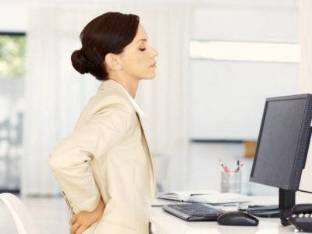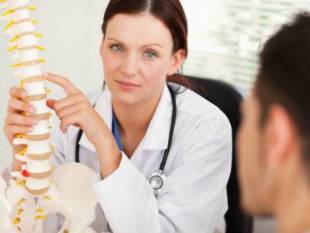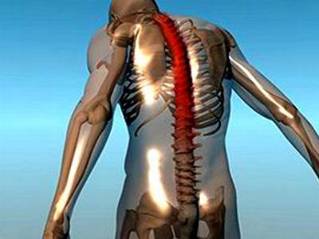If a man appeared back pain in the lumbar, the causes may be different and it's up to the renal pathology. Most often, this symptom is caused by diseases of the lumbar-sacral spine. The lumbar department is moving, that becomes the cause of more frequent injuries of this area.
Why developing painful?

Pain in the back — it is just a symptom. Acute pain in the lower back, coupled with the violation of the working lumbar vertebrae and discs, the so-called lumbago. Why it hurts your back at the bottom, everyone should know. Issue the following causes the occurrence of this symptom:
- osteochondrosis of the lumbar-sacral spine;
- a hernia between vertebrae;
- disease ankylosing Spondylitis;
- the offset of the vertebrae;
- congenital malformations of (the availability of incremental lumbar vertebrae, spina bifida);
- a congenital disorder of the shape of the vertebrae;
- benign, malignant and vascular tumors;
- rheumatism;
- inflammation of muscles (myositis);
- inflammation of the sciatic nerve;
- fractures of the spine;
- spondilolistezom;
- osteomyelitis;
- fibrositis;
- osteoporosis;
- protrusion of the disk;
- narrowing of the spinal canal;
- osteoarthritis;
- renal disease (hydronephrosis, pyelonephritis, tumors).
The spine in the lower back can hurt because of a simple muscle spasm. It is possible during heavy cornering or performing athletic exercises. Back pain in the lower back is more frequent in people who lead a sedentary life, and lift weights. In individuals engaged in sport, this pathology occurs much less often.
Sciatica osteochondrosis
If you constantly sore shoulders behind you, then it may be a manifestation of degenerative disc disease of the lumbar-sacral spine. It is a disease which mainly affects the discs between the vertebrae. Dwindling, which leads to friction between them and reduce the motility of the disk. Issue the following predisposing factors for developing this disease:
- stay spend hours in an uncomfortable position;
- the long slopes of the fuselage;
- lack of exercise in physical education classes;
- weakness in the muscles and the ligaments of the back;
- wear backpacks on the 1 strap;
- the availability of flat feet;
- heavy physical work;
- the larger the static load;
- improper arrangement of the working places.
Back pain is a major sign of degenerative disc disease. At 1 stage of the disease a painful missing. During the development of the protrusion of the disc develops lumbago. Is suddenly emerging pain in the lower back. Some people feel it as a blow to electric shock. It appears when a sharp change in position or while moving.
If the back hurts in the lumbar, then the cause may be lumbalgie. It's a chronic pain in osteochondrosis of the. Its appearance is not dependent on the physical activity of a person. The pain is aching. To such people it is difficult to bend the body. In the position the man lies on his back, a painful disappears or decreases.
In osteochondrosis of the 3 degrees develops root syndrome. It manifests itself lumborum ischialgia. It's a pain, that gives in the lower limb up to the fingers, feet. Often this is combined with impaired sensitivity. Discomfort in the lumbar driven by the compression of nerves, blood vessels and muscle spasm.
Symptoms of a hernia

If troubled by back pain, the causes may be in the intervertebral hernia. It is a very common disease. At her core disk of the vertebra is displaced. Often on the background of this happening is the difference of the fibrous rings. Prevalence is 150 cases per 100 thousand people. Issued the following possible causes of hernia:
- injuries (bruises, fall);
- osteochondrosis of the lumbar-sacral department;
- overweight;
- the curvature of the spinal column;
- the sharp turns.
In the risk group includes drivers and administrative staff who work at the computer. Pain when the hernia has the following features:
- is a local;
- it often gives to the thigh, buttocks and lower limbs;
- in combination with other symptoms (numbness, tingling);
- is amplified during physical exertion.
The severity of the pain syndrome is defined by the value of a hernia. If is large, then it can develop nerve. It is manifested by sciatica. Is it a strong pain in the form of lumbagoes.
In the majority of patients hernia develops pain according to the type of lumbago. The other symptoms of a hernia include a reduction of potency, limitation of motion of the lower back, weakness in the legs. Sometimes it is disturbed by urination.
Symptoms in ankylosing spondylitis
If it hurts your back, in the sacral area and lower back after a longer period of time, it can be suspected the disease ankylosing Spondylitis.
It is a chronic, systemic disease in which most often affects the joints of the spine. The exact causes of the disease are not established. Issued the following possible etiological factors:
- inflammation of the organs of the urinary system;
- hypothermia;
- injuries to the bones;
- genetic predisposition;
- infection.
Disease ankylosing Spondylitis occurs predominantly in younger persons aged 15 to 40 years. This pathology manifests itself in the joint and no joint symptoms. Back pain and stiffness of the spine are considered the most early symptom. Pain in the lumbar-sacral department. In the early stages it is expressed weakly. Its emergence is caused by inflammation.
The pain is two-way. Many people have pointed out, that the pain syndrome is most clearly expressed on the one hand. It takes more than 3 months and not being held. The disease develops very slowly. The pain, the worries of such people mostly in the morning. Maybe its appearance after a prolonged static load.
In the middle of the day it reduces. Painful it's better at rest and disappears during the work. The second phase of the summer solstice, the pain occurs at night and at work. In the later stages of develops nerve. Painful when the disease of ankylosing Spondylitis in combination with a deterioration of the overall well-being of a man, the limitations on the chest, puffy, omission of the head, pain in the muscles and chest. Often affects the eyes.
Kidney disease

If the back hurts in the lower back, then the cause may be renal disease (hydronephrosis or pyelonephritis). The kidneys are located retroperitoneal. In inflammation (pyelonephritis) pain in the lower back is the most common complaint among patients. This disease is often detected in children and young girls. Pyelonephritis often develops on the background of kidney disease.
The disease has an infectious nature. Most vividly acute pyelonephritis. It is characterized by pain in the lower back, nausea, increased body temperature, chills, weakness, malaise, frequent urination. Often appear swelling. The pain is most often unilateral, dull and constant. Radiation his is possible in the area of the hypochondrium, the lower part of the abdomen and the navel.
If they experienced pain in the lower back, the causes may be in hydronephrosis. It is a disease in which there is an enlargement of the kidney cups and pelvis. Often, this pathology develops in young children. On the basis of the development of hydronephrosis lies the violation of the outflow of urine, incorrect valves, and blockage of the urinary tract.
When hydronephrosis is appear sharp pain in the back. It is irradiating. It occurs in the side just above the pelvic bone. Paroxysmal pain, reminiscent of renal colic. Painful is combined with nausea, vomiting, appearance of blood in the urine.
Symptoms of sciatica
If strongly hurts the spine in the lumbar region, the cause may be inflammation of the sciatic nerve. This condition is called sciatica. The risk groups include persons of advanced age. Sciatica (sciatica), often develops on the background of intervertebral hernia, infectious diseases (influenza, malaria, tuberculosis), joint arthrosis, intoxication. Often sciatica occurs in pregnant.
Pain in the sciatica has the following features:
- acute (dagger);
- penetrating;
- intense;
- burning or shooting;
- originally appear in the lower part of the back, and then descends (they wear downward character);
- spread to the buttocks, thighs and lower leg;
- troubled by constantly in the form of seizures;
- has a different power;
- more often one-sided.
The pain is accompanied by tingling, numbness and mobility disorders. Other symptoms, without covers muscle atrophy, disorders of sweating, dryness and thinning of the skin.
Plan a survey of patients
Not everyone knows what to do when back hurts in the area of the lumbar. It is necessary to visit a doctor and undergo examination. You will need the following studies:
- computed tomography;
- radiography of the lumbar-sacral spine;
- ULTRASOUND of the kidneys;
- magnetic resonance imaging;
- electroneuromyography;
- Doppler of blood vessels;
- general and biochemical analysis of blood;
- analysis of the urine;
- cystourethrography.
Necessarily performed the inspection and palpation of the lumbar region and the spine. Requires the advice of a neurologist or vertebrologist. Upon examination, the doctor assesses the mobility of the spine, reflexes, muscle strength, range of motion in the limbs. Almost always is the cause of back pain are diseases of the spine. It is easy to identify on the image.
Therapeutic activities

If strongly hurts your back, then treatment should be directed at the underlying cause of the pain. Apply the following treatment methods:
- systemic drug therapy;
- the use of local pain medications in the form of gels and ointments;
- physiotherapy;
- manual therapy;
- acupuncture;
- of the blockade;
- surgical treatment;
- Movement therapy.
As the sick should practice gymnastics and adhere to the protein content of the diet. All performed the exercises should be of high amplitude. If the pain in the lower back is a sign of pyelonephritis, it is necessary to comply with bed rest, take pain medication and antibiotics. In chronic inflammation, in addition called diuretics. Of antibiotics is preferred to fluoroquinolones and penicillins.
In addition, they are appointed by the immunomodulators and vitamins. In the case of the development of the hydronephrosis may be necessary to surgical treatment. For headaches in the background, without the are applied analgesics (Analgin), the combined resources of the NSA. In severe cases requires novocaine blockade. In the scheme of treatment include massage, gymnastics, acupuncture.
For the removal of the pain can be distracting therapy. Used ointments with bee or snake venom. When the hernia shows the NSA, spinal traction, massage and therapeutic exercise. In severe cases surgery is required. When the pain on the background of sciatica treatment includes immobilization of the spine, the use of pain medications and intramuscular introduction of the anesthetic. In addition, there are vitamins of group B (Combilipen).
Effective and physiotherapy. If there is a degenerative disc disease shows kinesitherapy, massage, intake of pain medication, physical therapy. I'm sure they are appointed chondroprotectors. So sick it needs more movement and less time to spend standing up or sitting down. In the scheme of treatment include manual therapy and blockade. Therefore, the appearance of pain in the lower back is the reason for treatment to the hospital.

























